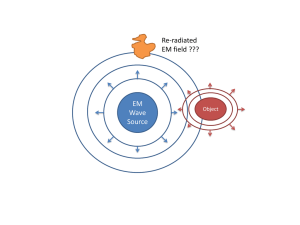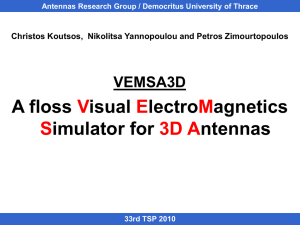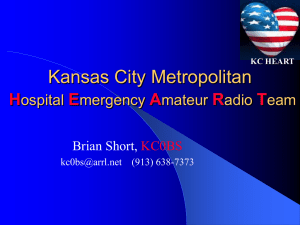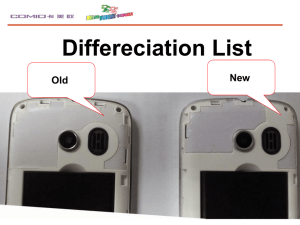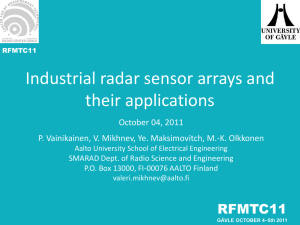Antennas and Propagation
advertisement
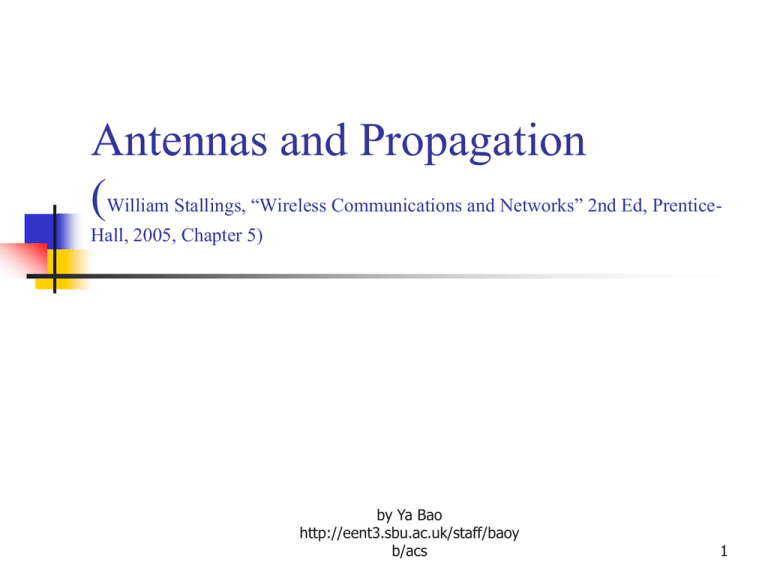
Antennas and Propagation (William Stallings, “Wireless Communications and Networks” 2nd Ed, PrenticeHall, 2005, Chapter 5) by Ya Bao http://eent3.sbu.ac.uk/staff/baoy b/acs 1 Introduction An antenna is an electrical conductor or system of conductors Transmission - radiates electromagnetic energy into space Reception - collects electromagnetic energy from space In two-way communication, the same antenna can be used for transmission and reception 2 Types of Antennas Isotropic antenna (idealized) Dipole antennas Radiates power equally in all directions Half-wave dipole antenna (or Hertz antenna) Quarter-wave vertical antenna (or Marconi antenna) Parabolic Reflective Antenna 3 Radiation Patterns Radiation pattern Graphical representation of radiation properties of an antenna Depicted as two-dimensional cross section Beam width (or half-power beam width) Measure of directivity of antenna 4 Radiation patterns Pdirectional G Pisotropic 5 Three-dimensional antenna radiation patterns. The top shows the directive pattern of a horn antenna, the bottom shows the omnidirectional pattern of a dipole antenna. 6 or as separate graphs in the vertical plane (E or V plane) and horizontal plane (H plane). This is often known as a polar diagram 7 8 9 outdoor enclosure featuring a wide band 2.5GHz panel antenna Gain (max) Frequency 3 dB beamwidth 16 dBi (+-0.5 dB) 2300 - 2700 MHz 30° (± 5°) Front to back (F/B ratio) 20 dB (± 3 dB) 10 Other antennas Helical Antenna Patch (microstrip) antenna Multiband antenna: for GSM 900+GSM 1800+GSM 1900+Bluetooth; or GSM and 3G 11 Antenna Gain Antenna gain Power output, in a particular direction, compared to that produced in any direction by a perfect omnidirectional antenna (isotropic antenna) Effective area Related to physical size and shape of antenna 12 Antenna Gain Relationship between antenna gain and effective area G 4Ae 2 4f Ae c2 2 G = antenna gain Ae = effective area f = carrier frequency c = speed of light ( 3 108 m/s) = carrier wavelength 13 14 Propagation Models Ground Wave (GW) Propagation: < 3MHz Sky Wave (SW) Propagation: 3MHz to 30MHz Effective Line-of-Sight (LOS) Propagation: > 30MHz 15 Ground Wave Propagation – – – – Follows contour of the earth. Can propagate considerable distances. Frequency bands: ELF, VF, VLF, LF, MF. Spectrum range: 30Hz ~ 3MHz, e.g. AM radio. 16 Sky Wave Propagation – – – Signal reflected from ionized layer of upper atmosphere back down to earth, wh can travel a number of hops, back and forth between ionosphere and earth’s surface. HF band with intermediate frequency range: 3MHz ~ 30MHz. e.g: International broadcast. 17 Line-of-Sight Propagation Tx. and Rx. antennas are in the effective ‘line of sight’ range. Includes both LOS and non-LOS (NLOS) case For satellite communication, signal above 30 MHz not reflected by ionosphere. For ground communication, antennas within effective LOS due to refraction. Frequency bands: VHF, UHF, SHF, EHF, Infrared, optical light Spectrum range : 30MHz ~ 900THz. 18 LOS calculations dr do earth optical horizon radio horizon What is the relationship between h and d ? – For optical LOS: where do 3.57 h – For effective or radio LOS: dr 3.57 Kh h = antenna height (m) d = distance between antenna and horizon (km) K = adjustment factor for19 refraction, K = 4/3 Line-of-Sight Equations Effective, or radio, line of sight d 3.57 h d = distance between antenna and horizon (km) h = antenna height (m) K = adjustment factor to account for refraction, rule of thumb K = 4/3 Maximum distance between two antennas for LOS propagation: d 3.57 h1 h2 20 LOS Wireless Transmission Impairments Attenuation and attenuation distortion Free space loss Noise Atmospheric absorption Multipath Refraction Thermal noise 21 Attenuation Strength of signal falls off with distance over transmission medium Attenuation factors for unguided media: Received signal must have sufficient strength so that circuitry in the receiver can interpret the signal Signal must maintain a level sufficiently higher than noise to be received without error Attenuation is greater at higher frequencies, causing distortion 22 Free Space Loss Free space loss, ideal isotropic antenna Pt 4d 4fd 2 2 Pr c 2 2 Pt = signal power at transmitting antenna Pr = signal power at receiving antenna = carrier wavelength d = propagation distance between antennas 8 c = speed of light ( 3 10 m/s) where d and are in the same units (e.g., meters) 23 Free Space Loss Free space loss equation can be recast: Pt 4d LdB 10 log 20 log Pr 20log 20logd 21.98 dB 4fd 20log 20log f 20logd 147.56 dB c 24 Pt 4fd 4fd 4d 20 log 10 log 10 log 2 2 c c Pr 2 LdB 2 20 log( f ) 20 log(d ) 20 log 4 20 log 20 log c 20 log( f ) 20 log(d ) 12.04 9.94 20 log(3 108 ) 20 log( f ) 20 log(d ) 12.04 9.94 9.54 20 8 20 log( f ) 20 log(d ) 147.56dB 25 Free Space Loss Free space loss accounting for gain of other antennas can be recast as LdB 20log 20logd 10log At Ar 20log f 20logd 10log At Ar 169.54dB 26 Categories of Noise Thermal Noise Intermodulation noise Crosstalk Impulse Noise 27 Noise (1) Thermal noise due to thermal agitation of electrons. Present in all electronic devices and transmission media. As a function of temperature. Uniformly distributed across the frequency spectrum, hence often referred as white noise. Cannot be eliminated – places an upper bound on the communication system performance. Can cause erroneous to the transmitted digital data bits. 28 Noise (2): Noise on digital data Error in bits 29 Thermal Noise The noise power density (amount of thermal noise to be found in a bandwidth of 1Hz in any device or conductor) is: N0 kT W/Hz N0 = noise power density in watts per 1 Hz of bandwidth k = Boltzmann's constant = 1.3803 10-23 J/K T = temperature, in kelvins (absolute temperature) 0oC = 273 Kelvin 30 Thermal Noise Noise is assumed to be independent of frequency Thermal noise present in a bandwidth of B Hertz (in watts): N kTB or, in decibel-watts (dBW), N 10log k 10 log T 10log B 228.6 dBW 10 log T 10log B 31 Noise Terminology Intermodulation noise – occurs if signals with different frequencies share the same medium Interference caused by a signal produced at a frequency that is the sum or difference of original frequencies Crosstalk – unwanted coupling between signal paths Impulse noise – irregular pulses or noise spikes Short duration and of relatively high amplitude Caused by external electromagnetic disturbances, or faults and flaws in the communications system 32 Signal to Noise Ratio – SNR (1) Ratio of the power in a signal to the power contained in the noise present at a particular point in the transmission. Normally measured at the receiver with the attempt to eliminate/suppressed the unwanted noise. In decibel unit, PS SNR dB 10log10 PN where PS = Signal Power, PN = Noise Power Higher SNR means better quality of signal. 33 Signal to Noise Ratio – SNR (2) SNR is vital in digital transmission because it can be used to sets the upper bound on the achievable data rate. Shannon’s formula states the maximum channel capacity (error-free capacity) as: C B log2 1 SNR Given the knowledge of the receiver’s SNR and the signal bandwidth, B. C is expressed in bits/sec. In practice, however, lower data rate are achieved. For a fixed level of noise, data rate can be increased by 34 increasing the signal strength or bandwidth. Expression of Eb/N0 (1) Another parameter that related to SNR for determine data rates and error rates is the ratio of signal energy per bit, Eb to noise power density per Hertz, N0; → Eb/N0. The energy per bit in a signal is given by: Eb PS Tb PS = signal power & Tb = time required to send one bit which can be related to the transmission bit rate, R, as Tb = 1/ R. Thus, Eb PS / R PS N0 N0 kTR – 228.6 dBW In decibels: Eb P S ( dB ) 10log10 R 10log10 k 10log10T N 0 dB 35 Expression of Eb/N0 (2) As the bit rate R increases, the signal power PS relative to the noise must also be increased to maintain the required Eb/N0. The bit error rate (BER) for the data sent is a function of Eb/N0 (see the BER versus Eb/N0 plot). Eb/N0 is related to SNR as: PS B Eb B SNR N0 R PN R where B = Bandwidth, R = Bit rate BER versus Eb/N0 plot Higher Eb/N0, lower BER 36 Wireless Propagation Mechanisms Basic types of propagation mechanisms Free space propagation LOS wave travels large distance with obstacle-free reflection Reflection Wave impinges on an object which is large compared to the wave-length diffraction Diffraction Occurs when wave hits the sharp edge of the obstacles and bent around to propagate further in the ‘shadowed’ regions – Fresnel zones. Scattering Wave hits the objects smaller than itself. e.g. street signs and lamp posts. Lamp post scattering 37

